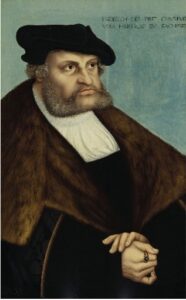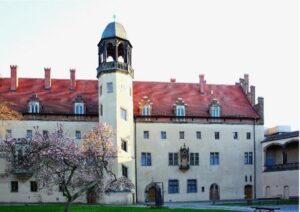Alpha to the Omega: U is for…University of Wittenberg

Alpha to the Omega
Samuel Chong
U is for…University of Wittenberg
“I applied my mind to study and to explore by wisdom all that is done under the heavens.” (Ecclesiastes 1:13)

What was the University of Wittenberg?
The University of Wittenberg was a university in Saxony, Germany. It is most famous for being the workplace and residence of Martin Luther in the early days of the Reformation. The University was later merged with the University of Halle and is today known as the Martin Luther University of Halle-Wittenberg. The University of Wittenberg was a significant location for many important developments in the Reformation.
The University in the White Mountain
Wittenberg (White Mountain) was an important trade centre because of its central location in Germany. It also became an important regional political and cultural centre at the end of the 1400s, when Frederick III “the Wise”, Elector of Saxony from 1486-1525, made his residence there.

In 1502, Elector Frederick founded the University of Wittenberg to train lawyers, theologians, and physicians for the service of Saxony. This was to build on the momentum of the Renaissance – a period of advances in art, literature, the sciences, mathematics, and culture across Europe.
Prominent academics were recruited for the new university, who gave the institution the Greek name Leucorea (Wittenberg in Greek). The university was also aligned with the existing universities in Germany in terms of content and structure; the Faculty of Philosophy laid the foundation on which the Faculties of Law, Medicine, and Theology were built. [Author’s note: That’s why PhD is short for Doctor of Philosophy]
Martin Matriculates
The first Dean of the Faculty of Theology was Johann von Staupitz, Vicar General of the Augustinian Friars in Germany and the Father Confessor of Martin Luther during his years as an Augustinian monk.
Luther chose to forsake his legal studies and joined the Augustinian Order after his experience in the thunderstorm (“Help me St Anne, I will become a monk!”), devoting himself to fasting, prayer, and frequent confession. Luther would confess his sins to Johann von Staupitz for hours on end, frustrating the latter. Von Staupitz concluded that Luther needed more work to distract him from excessive introspection and ordered him to pursue an academic career.
After his ordination in 1507, Luther began teaching theology at the University of Wittenberg in 1508 and was awarded his Doctor of Theology in 1512 [Author’s note: That’s why Luther is referred to as “Dr Luther” in some sources]. Luther eventually succeeded von Staupitz as Chair of Theology and would spend the rest of his career in this position at the university.
The Doctor is in the House
Luther lived on campus, in an Augustinian cloister. It was during his time living here that Luther wrote his Ninety-Five Theses. He continued to live in Wittenberg even after the Reformation first started in 1517, until he was temporarily hidden by Elector Frederick at Wartburg Castle after the Diet of Worms in 1521. Luther only returned to Wittenberg in 1524 after the university was partially abandoned amidst a mass peasant revolt stemming from the Reformation.
The Electorate of Saxony granted Luther residence in the now-empty cloister, where he subsequently raised his family, taught students, and revised his translation of the Bible which he started at Wartburg Castle. He continued to live here for most of his adult life. The building was sold back to the university in 1564 after Luther’s death and is known today as the Lutherhaus.
Philip Melanchthon, the other great reformer and shaper of Lutheranism, also held a faculty position at Wittenberg. He was initially appointed professor of Greek in 1518 upon Luther’s invitation, later transferring to the Faculty of Theology.

Merger
About a century later, another university was founded in 1694 in Halle, 60km away from Wittenberg. This university was also founded by an Elector Frederick, this time Frederick III, Elector of Brandenburg, who later became King in Prussia in 1701.
By this time, Halle had become Prussia’s centre for Pietism – a Lutheran movement that combined emphasis on Biblical doctrine with individual piety and holy living. Ironically, its university was a centre of the German Enlightenment – rationalism was prioritised over religious orthodoxy, lectures were held in German rather than Latin, undermining the hitherto unquestioned superiority of aristocracy and theology. [Author’s note: Much can be said about the “damage” done by 18th and 19th century German scholars to the Church, not least the promotion of textual criticism of the Bible which undermined belief in its inerrancy, however this requires an entire article on its own.]
After the Napoleonic Wars, Wittenberg was granted to Prussia in 1815, and the University of Wittenberg was merged with the University of Halle in 1817. The merged university was given present name in 1933, to commemorate the 450th anniversary of Luther’s birth.
Today, the Martin Luther University of Halle-Wittenberg’s main campus is in Halle, while the Leucorea Foundation in Wittenberg serves as its convention centre.

“To wi (be) or not to wi (be)” – Wittenberg U in Popular Culture
The University of Wittenberg counts several famous fictional characters as alumni, such as Prince Hamlet (from Shakespeare’s Hamlet) and Doctor Faustus (from Christopher Marlowe’s Faustus).
Conclusion
The University of Wittenberg was a centre of the Protestant Reformation, being literally where Luther lived and developed his ideas, which were then furthered by Melanchthon who also taught at Wittenberg. European universities in general show how the same institution can follow the trend of initially promoting religious thinking and orthodoxy (be it Catholic or Protestant), only to subsequently challenge the Church and faith altogether (e.g. Protestant Reformation, Enlightenment).
All information and pictures taken from the respective Wikipedia articles unless otherwise stated.
Further Reading







Responses